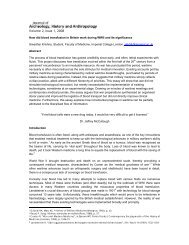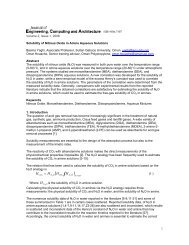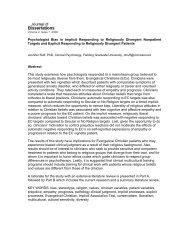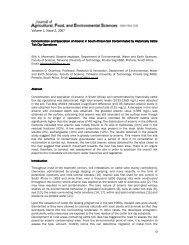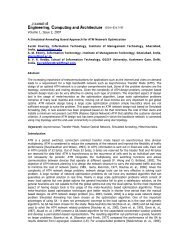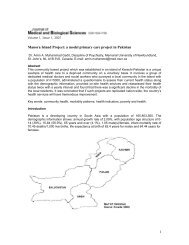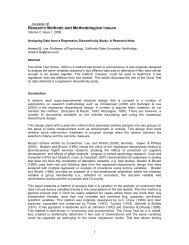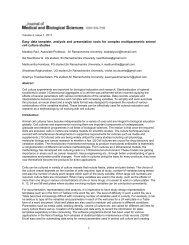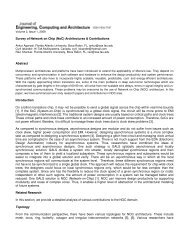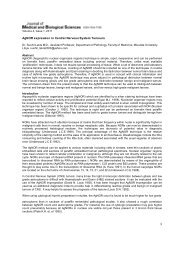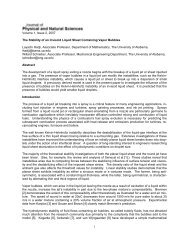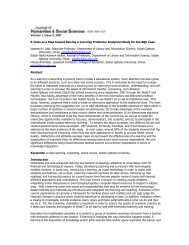The Heaven and Earth Society and the Red Turban Rebellion in ...
The Heaven and Earth Society and the Red Turban Rebellion in ...
The Heaven and Earth Society and the Red Turban Rebellion in ...
Create successful ePaper yourself
Turn your PDF publications into a flip-book with our unique Google optimized e-Paper software.
extensively various k<strong>in</strong>ds of secondary sources <strong>in</strong> English, Ch<strong>in</strong>ese, Japanese, <strong>and</strong> Korean. This<br />
background work provides a context for analysis of <strong>the</strong> series of conflicts that I have chosen to study, for<br />
comparison with o<strong>the</strong>r conflicts will help to identify <strong>the</strong> dist<strong>in</strong>ctive elements that shaped <strong>the</strong> <strong>Red</strong> <strong>Turban</strong><br />
<strong>Rebellion</strong>.<br />
Primary historical material on my study can be divided <strong>in</strong>to three different categories: official reports<br />
<strong>and</strong> observations <strong>and</strong> local histories, biographies of local leaders, <strong>and</strong> foreign accounts of life <strong>in</strong> Guangdong.<br />
Detailed reports by local officials from n<strong>in</strong>eteenth-century Ch<strong>in</strong>a are rare, <strong>in</strong> part because of <strong>the</strong><br />
adm<strong>in</strong>istrative practice of discard<strong>in</strong>g lower-level reports <strong>and</strong> <strong>in</strong> part because of <strong>the</strong> series of rebellions, wars,<br />
<strong>and</strong> revolutions that destroyed so many primary documents from pre-twentieth century Ch<strong>in</strong>a. By a curious<br />
irony of history, however, it was <strong>the</strong> British who preserved <strong>the</strong> collection of Ch<strong>in</strong>ese official documents that<br />
provides <strong>the</strong> richest source of <strong>in</strong>formation about <strong>the</strong> <strong>Red</strong> <strong>Turban</strong> <strong>Rebellion</strong>s. When <strong>the</strong> British occupied <strong>the</strong><br />
office of <strong>the</strong> prov<strong>in</strong>cial government <strong>in</strong> Guangzhou <strong>in</strong> 1858, <strong>the</strong>y took possession of all papers <strong>the</strong>y found<br />
<strong>the</strong>re, <strong>in</strong>clud<strong>in</strong>g both adm<strong>in</strong>istrative documents <strong>and</strong> private correspondence between <strong>the</strong> viceroy of<br />
Liang’guang 兩 廣 (Guangdong <strong>and</strong> Guangxi) <strong>and</strong> <strong>the</strong> Q<strong>in</strong>g court; even after <strong>the</strong> conclusion of peace with<br />
Ch<strong>in</strong>a, this collection was reta<strong>in</strong>ed <strong>and</strong> deposited <strong>in</strong> <strong>the</strong> British Legation <strong>in</strong> Beij<strong>in</strong>g, where it served as a file<br />
of <strong>in</strong>telligence materials. Eventually it was sent to London <strong>and</strong> f<strong>in</strong>ally came to rest <strong>in</strong> <strong>the</strong> Public Record<br />
Office, where it is known as <strong>the</strong> Foreign Office Archives or <strong>the</strong> Canton Archives. 3 Preserved as it was<br />
orig<strong>in</strong>ally found, it is a uniquely comprehensive record of prov<strong>in</strong>cial adm<strong>in</strong>istration <strong>in</strong> <strong>the</strong> mid-n<strong>in</strong>eteenth<br />
century. 4 S<strong>in</strong>ce <strong>the</strong> <strong>Red</strong> <strong>Turban</strong>s were a direct threat to Guangdong prov<strong>in</strong>ce, <strong>the</strong> official reports <strong>in</strong> <strong>the</strong><br />
Canton Archives <strong>in</strong>clude abundant manuscripts on <strong>the</strong>ir rebellions.<br />
Some <strong>in</strong>formation on <strong>the</strong> <strong>Red</strong> <strong>Turban</strong> <strong>Rebellion</strong>s is also conta<strong>in</strong>ed <strong>in</strong> <strong>the</strong> form of memorials sent by<br />
prov<strong>in</strong>cial officials to <strong>the</strong> emperor, now <strong>in</strong> <strong>the</strong> Gr<strong>and</strong> Council Reference Files (Junjichu zouzhe lufu 軍 機 處 奏<br />
摺 錄 副 ) <strong>in</strong> <strong>the</strong> First Historical Archives at Beij<strong>in</strong>g. 5 <strong>The</strong> Emperor's response to <strong>the</strong>se memorials can be found<br />
<strong>in</strong> <strong>the</strong> Daq<strong>in</strong>g lichao shilu 大 清 歷 朝 實 錄 . <strong>The</strong> richest sources, however, are prov<strong>in</strong>cial, prefectural, <strong>and</strong><br />
county histories or gazetteers. <strong>The</strong> gazetteer is a special genre of literature <strong>in</strong> Ch<strong>in</strong>ese historical writ<strong>in</strong>g, <strong>and</strong><br />
chuan, Rural Ch<strong>in</strong>a: Imperial Control <strong>in</strong> <strong>the</strong> N<strong>in</strong>eteenth Century (Seattle: University of Wash<strong>in</strong>gton Press,<br />
1967); Wakeman, Strangers; Philip Kuhn, <strong>Rebellion</strong> <strong>and</strong> its Enemies <strong>in</strong> Late Imperial Ch<strong>in</strong>a; Albert<br />
Feuerwerker, <strong>Rebellion</strong> <strong>in</strong> N<strong>in</strong>eteenth-Century Ch<strong>in</strong>a (Ann Arbor: Center for Ch<strong>in</strong>ese Studies, University<br />
of Michigan, 1975).<br />
3 David Pong, A Critical Guide to <strong>the</strong> Kwangtung Prov<strong>in</strong>cial Archives: Deposited at <strong>the</strong> Public Record of<br />
Office of London (Cambridge <strong>and</strong> London: Harvard University Press, 1975).<br />
4 Even though Chang Hs<strong>in</strong>-pao (1964) <strong>and</strong> Sasaki Masaya (1967) identified <strong>and</strong> <strong>in</strong>troduced <strong>the</strong>se<br />
documents, surpris<strong>in</strong>gly, very few historians have used <strong>the</strong>m to study <strong>the</strong> rebellions of <strong>the</strong> Pearl River Delta<br />
dur<strong>in</strong>g <strong>the</strong> mid-n<strong>in</strong>eteenth century. This source has been tapped to some extent <strong>in</strong> a study by Wakeman<br />
(1966); however, his work only relied on materials written <strong>in</strong> English among Foreign Office records,<br />
materials that give an <strong>in</strong>complete picture of developments <strong>in</strong> <strong>the</strong> Pearl River Delta. See Chang Hs<strong>in</strong>-pao,<br />
Commissioner L<strong>in</strong> <strong>and</strong> <strong>the</strong> Opium War(Cambridge: Harvard University Press, 1964); Sasaki Masaya 々<br />
, Sh<strong>in</strong>matsu no himitsu kessha (Tokyo: K<strong>in</strong>dai Chūgoku Kenkyū I<strong>in</strong>kai, 1967); Lu<br />
Baoqian , Lun wan-q<strong>in</strong>g Liangguang de Ti<strong>and</strong>ihui zhengquan (Taibei:<br />
Zhongyang yanjiu j<strong>in</strong>daishi yanjiusuo, 1975); Frederic Wakeman Jr., "<strong>The</strong> Secret Societies of Kwangtung,<br />
1800-1856," <strong>in</strong> Popular Movements, ed. Jean Chesneaux; Idem, Strangers at <strong>the</strong> Gate: Social Disorder <strong>in</strong><br />
South Ch<strong>in</strong>a, 1839-18 (Berkeley: University of California Press, 1966).<br />
5 Although <strong>the</strong>re are many publications of archival documents from <strong>the</strong> Q<strong>in</strong>g by Ch<strong>in</strong>ese archivists [for<br />
example, <strong>the</strong> edited collection of documents from <strong>the</strong> Number One Historical Archive <strong>in</strong> Beij<strong>in</strong>g on <strong>the</strong><br />
pre-Opium War Ti<strong>and</strong>ihui: Q<strong>in</strong> Baoqi <strong>and</strong> Liu Meizhen eds., Ti<strong>and</strong>ihui . 7<br />
volumes (Beij<strong>in</strong>g: <strong>The</strong> Number One Historical Archive, 1981-89)], thous<strong>and</strong>s of documents on various<br />
subjects have not yet been published. Thus, many historians still need to visit <strong>the</strong> Number One Historical<br />
Archive to pore through <strong>the</strong> enormous mass of poorly arranged documents for <strong>the</strong>ir research. For excellent<br />
guides to <strong>the</strong> use of <strong>the</strong>se archival materials, see Beatrice S Bartlett, Ch'<strong>in</strong>g documents <strong>in</strong> <strong>the</strong> National<br />
Palace Museum Archives, (Taibei: National Palace Museum, 1975); idem, Archival Materials <strong>in</strong> Ch<strong>in</strong>a on<br />
United States History, (White Pla<strong>in</strong>s, N.Y.: Kraus International Publications, 1985); idem, Selected articles<br />
from Taipei National Palace Museum bullet<strong>in</strong>, 1972-1979, (Taibei: National Palace Museum, 1972-79);<br />
Joseph Esherick, Ch<strong>in</strong>ese Archives: An Introductory Guide, (Berkeley : Institute of East Asian Studies,<br />
University of California, Berkeley, Center for Ch<strong>in</strong>ese Studies, 1996).<br />
2



